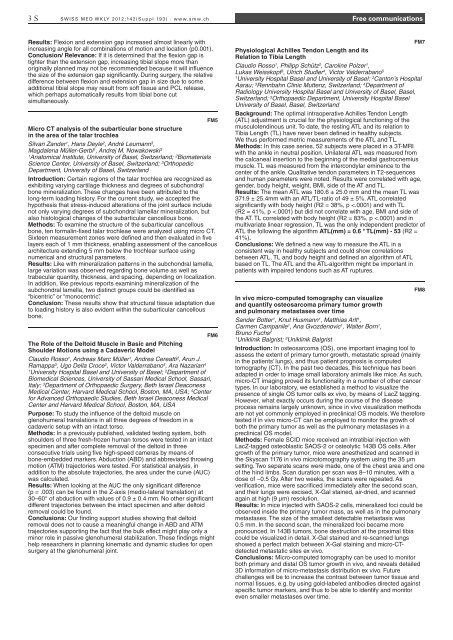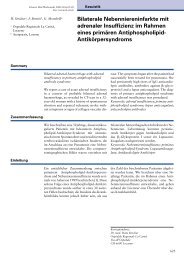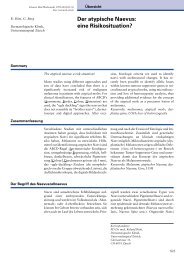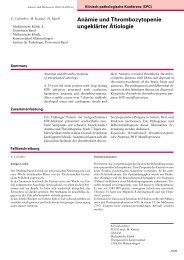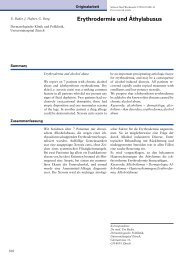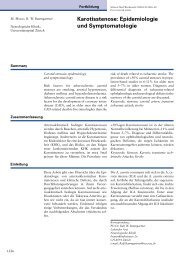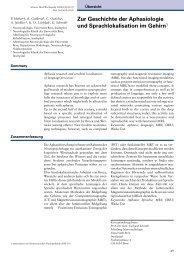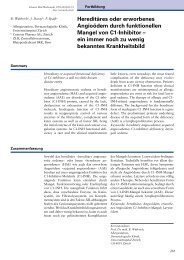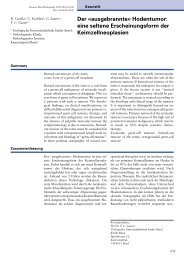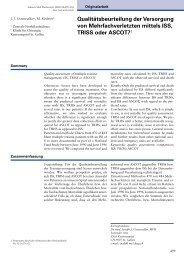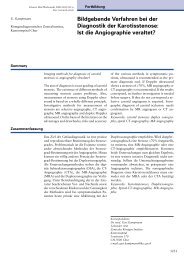SMW Supplementum 193 - Swiss Medical Weekly
SMW Supplementum 193 - Swiss Medical Weekly
SMW Supplementum 193 - Swiss Medical Weekly
You also want an ePaper? Increase the reach of your titles
YUMPU automatically turns print PDFs into web optimized ePapers that Google loves.
3 S SWiSS Med Wkly 2012;142(Suppl <strong>193</strong>) · www.smw.ch Free communications<br />
Results: Flexion and extension gap increased almost linearly with<br />
increasing angle for all combinations of motion and location (p0.001).<br />
Conclusion/ Relevance: If it is determined that the flexion gap is<br />
tighter than the extension gap, increasing tibial slope more than<br />
originally planned may not be recommended because it will influence<br />
the size of the extension gap significantly. During surgery, the relative<br />
difference between flexion and extension gap in size due to some<br />
additional tibial slope may result from soft tissue and PCL release,<br />
which perhaps automatically results from tibial bone cut<br />
simultaneously.<br />
FM5<br />
Micro CT analysis of the subarticular bone structure<br />
in the area of the talar trochlea<br />
Silvan Zander1 , Hans Deyle2 , André Leumann3 ,<br />
Magdalena Müller-Gerbl1 , Andrej M. Nowakowski3 1Anatomical Institute, University of Basel, Switzerland; 2Biomaterials Science Center, University of Basel, Switzerland; 3Orthopedic Department, University of Basel, Switzerland<br />
Introduction: Certain regions of the talar trochlea are recognized as<br />
exhibiting varying cartilage thickness and degrees of subchondral<br />
bone mineralization. These changes have been attributed to the<br />
long-term loading history. For the current study, we accepted the<br />
hypothesis that stress-induced alterations of the joint surface include<br />
not only varying degrees of subchondral lamellar mineralization, but<br />
also histological changes of the subarticular cancellous bone.<br />
Methods: To examine the structure of the subarticular cancellous<br />
bone, ten formalin-fixed talar trochleae were analyzed using micro CT.<br />
Sixteen measurement zones were defined and then evaluated in five<br />
layers each of 1 mm thickness, enabling assessment of the cancellous<br />
architecture extending 5 mm below the trochlear surface using<br />
numerical and structural parameters.<br />
Results: Like with mineralization patterns in the subchondral lamella,<br />
large variation was observed regarding bone volume as well as<br />
trabecular quantity, thickness, and spacing, depending on localization.<br />
In addition, like previous reports examining mineralization of the<br />
subchondral lamella, two distinct groups could be identified as<br />
“bicentric” or “monocentric”.<br />
Conclusion: These results show that structural tissue adaptation due<br />
to loading history is also evident within the subarticular cancellous<br />
bone.<br />
FM6<br />
The Role of the Deltoid Muscle in Basic and Pitching<br />
Shoulder Motions using a Cadaveric Model<br />
Claudio Rosso1 , Andreas Marc Müller1 , Andrea Cereatti2 , Arun J.<br />
Ramappa3 , Ugo Della Croce2 , Victor Valderrabano4 , Ara Nazarian4 1 2 University Hospital Basel and University of Basel; Department of<br />
Biomedical Sciences, University of Sassari <strong>Medical</strong> School, Sassari,<br />
Italy; 3Department of Orthopaedic Surgery, Beth Israel Deaconess<br />
<strong>Medical</strong> Center, Harvard <strong>Medical</strong> School, Boston, MA, USA; 4Center for Advanced Orthopaedic Studies, Beth Israel Deaconess <strong>Medical</strong><br />
Center and Harvard <strong>Medical</strong> School, Boston, MA, USA<br />
Purpose: To study the influence of the deltoid muscle on<br />
glenohumeral translations in all three degrees of freedom in a<br />
cadaveric setup with an intact torso.<br />
Methods: In a previously published, validated testing system, both<br />
shoulders of three fresh-frozen human torsos were tested in an intact<br />
specimen and after complete removal of the deltoid in three<br />
consecutive trials using five high-speed cameras by means of<br />
bone-embedded markers. Abduction (ABD) and abbreviated throwing<br />
motion (ATM) trajectories were tested. For statistical analysis, in<br />
addition to the absolute trajectories, the area under the curve (AUC)<br />
was calculated.<br />
Results: When looking at the AUC the only significant difference<br />
(p = .003) can be found in the Z-axis (medio-lateral translation) at<br />
30–60° of abduction with values of 0.9 ± 0.4 mm. No other significant<br />
different trajectories between the intact specimen and after deltoid<br />
removal could be found.<br />
Conclusions: Our finding support studies showing that deltoid<br />
removal does not to cause a meaningful change in ABD and ATM<br />
trajectories supporting the fact that the bulk effect might play only a<br />
minor role in passive glenohumeral stabilization. These findings might<br />
help researchers in planning kinematic and dynamic studies for open<br />
surgery at the glenohumeral joint.<br />
FM7<br />
Physiological Achilles Tendon Length and its<br />
Relation to Tibia Length<br />
Claudio Rosso1 , Philipp Schütz2 , Caroline Polzer1 ,<br />
Lukas Weisskopf3 , Ulrich Studler4 , Victor Valderrabano5 1 2 University Hospital Basel and University of Basel: Canton’s Hospital<br />
Aarau; 3Rennbahn Clinic Muttenz, Switzerland; 4Department of<br />
Radiology University Hospital Basel and University of Basel, Basel,<br />
Switzerland; 5Orthopaedic Department, University Hospital Basel<br />
University of Basel, Basel, Switzerland<br />
Background: The optimal intraoperative Achilles Tendon Length<br />
(ATL) adjustment is crucial for the physiological functioning of the<br />
musculotendinous unit. To date, the resting ATL and its relation to<br />
Tibia Length (TL) have never been defined in healthy subjects.<br />
We thus performed metric measurements of the ATL and TL.<br />
Methods: In this case series, 52 subjects were placed in a 3T-MRI<br />
with the ankle in neutral position. Unilateral ATL was measured from<br />
the calcaneal insertion to the beginning of the medial gastrocnemius<br />
muscle. TL was measured from the intercondylar eminence to the<br />
center of the ankle. Qualitative tendon parameters in T2-sequences<br />
and human parameters were noted. Results were correlated with age,<br />
gender, body height, weight, BMI, side of the AT and TL.<br />
Results: The mean ATL was 180.6 ± 25.0 mm and the mean TL was<br />
371.9 ± 25.4mm with an ATL/TL-ratio of 49 ± 5%. ATL correlated<br />
significantly with body height (R2 = 38%, p


